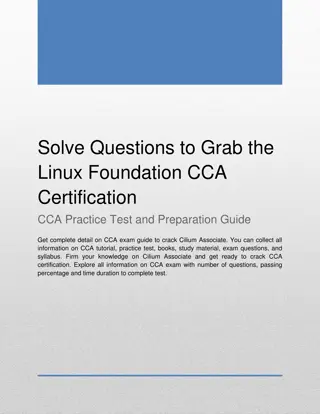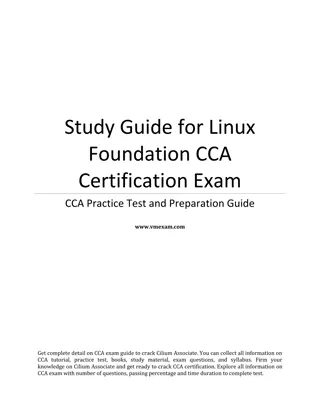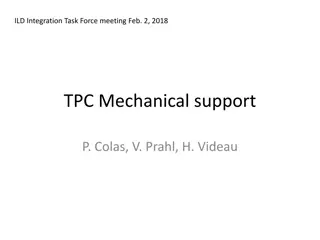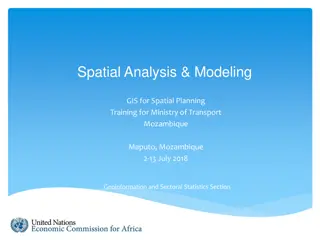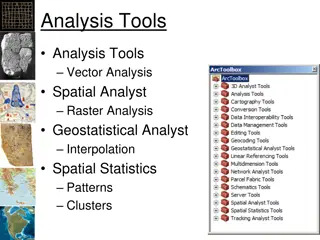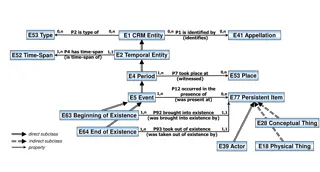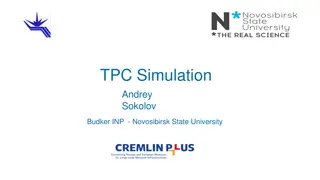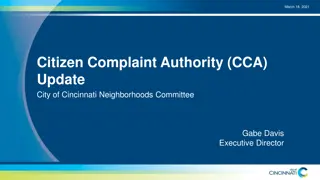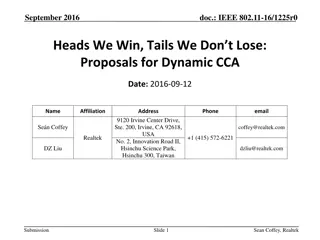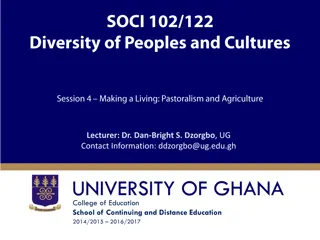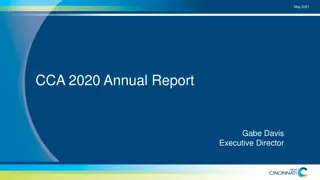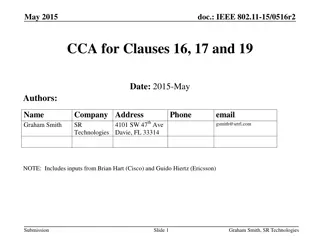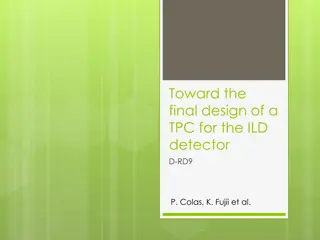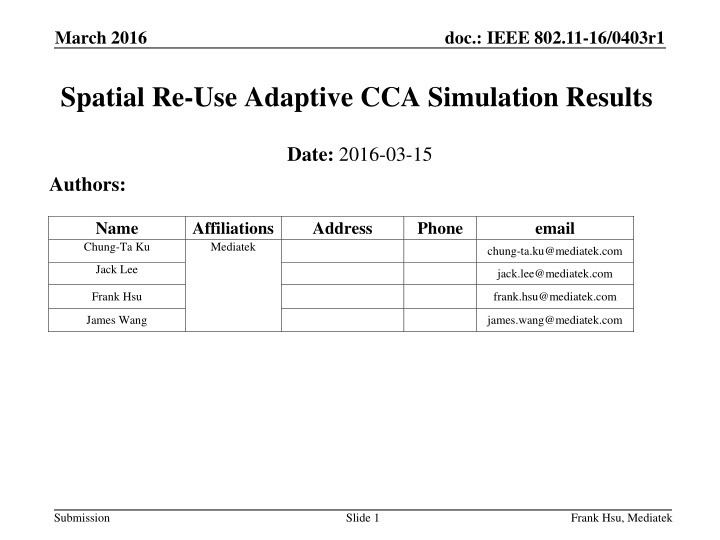
IEEE 802.11-16/0403r1 Spatial Re-Use Adaptive CCA Simulation Results
Presentation discussing simulation results on open loop OBSS_PD adjustment and transmit power control in IEEE 802.11-16/0403r1, including methods for adjusting OBSS_PD levels and implementing suitable TPC. The study focuses on static OBSS_PD adjustment, balanced OBSS_PD adjustment with TPC, RSSI-based OBSS_PD adjustment with TPC, and simulation parameters used in a simplified residential scenario. Deployment strategies and evaluation metrics for legacy and 11ax devices in various channels are also covered.
Download Presentation

Please find below an Image/Link to download the presentation.
The content on the website is provided AS IS for your information and personal use only. It may not be sold, licensed, or shared on other websites without obtaining consent from the author. If you encounter any issues during the download, it is possible that the publisher has removed the file from their server.
You are allowed to download the files provided on this website for personal or commercial use, subject to the condition that they are used lawfully. All files are the property of their respective owners.
The content on the website is provided AS IS for your information and personal use only. It may not be sold, licensed, or shared on other websites without obtaining consent from the author.
E N D
Presentation Transcript
March 2016 doc.: IEEE 802.11-16/0403r1 Spatial Re-Use Adaptive CCA Simulation Results Date: 2016-03-15 Authors: Name Chung-Ta Ku Affiliations Mediatek Address Phone email chung-ta.ku@mediatek.com Jack Lee jack.lee@mediatek.com Frank Hsu frank.hsu@mediatek.com James Wang james.wang@mediatek.com Submission Slide 1 Frank Hsu, Mediatek
doc.: IEEE 802.11-16/0403r1 Introduction In this presentation, simulation results of open loop OBSS_PD adjustment and transmit power control (TPC) are presented Submission
doc.: IEEE 802.11-16/0403r1 Open Loop Methods When packets are detected from OBSS, the OBSS_PD level should be adjusted and suitable TPC needs to be considered as well Among IEEE space reuse contributions, there are mainly three types of open loop methods Static OBSS_PD adjustment , No TPC Static & Balanced OBSS_PD adjustment + TPC RSSI-Based & Balanced OBSS_PD adjustment + TPC Submission
BSS 1 BSS 2 doc.: IEEE 802.11-16/0403r1 Method Summary Legacy PD Range 1. Static OBSS_PD adjustment, No TPC -Increased CCA is fixed -not considerate at all OBSS PD Range 2. Static & Balanced OBSS_PD adjustment + TPC -Increased CCA = Reduction PWR ( fixed) -considerate DynamicValue RaiesdCCAmax 3. RSSI-Based & Balanced OBSS_PD adjustment + TPC -Increased CCA = Reduction PWR = min(DynamicValue, RaiesdCCAmax) - DynamicValue is from RSSI OBSS_PD base - very considerate Submission
doc.: IEEE 802.11-16/0403r1 Simulation Parameters Use a simplified scenario based on 11ax residential scenario 2 x 5 x 10 = 100 apt. in a building One pair of AP/STA in each apt. Random factor Location of AP/STA in each apartment Use one channel out of three (0, 1, 2) Shadowing effect Power setting TX Power: AP: 20dBm, STA: 15dBm Standard CCA in 20MHz: -82dBm AP/STA are BW 20 MHz Other simplification Link adaptation: assign best MCS that can sustain 10% PER by looking up SINR-PER table No MAC overhead No collision Submission Slide 5 Frank Hsu, MediaTek Inc.
doc.: IEEE 802.11-16/0403r1 Deployment Initially: Whole building is empty. Procedure: Deploy 11ax SR and legacy devices one by one with specified selection probability p and 1-p at apartments using ch0 Successfully deployed if interference from all other deployed BSSs is less than adjusted OBSS_PD 33 AP/STA pairs in ch0 Evaluation Metrics: Total system throughput System gain Follow procedure Legacy or 11ax Ch0 Ch0 Ch2 Ch1 Ch2 1st RX 1st TX Ch2 Ch1 Ch0 Ch2 Ch0 1st TX 1st TX TX Legacy or 11ax Legacy or 11ax RX Submission Slide 6 Frank Hsu, MediaTek Inc.
doc.: IEEE 802.11-16/0403r1 Total System Throughput (mcs0: 1, mcs1: 2, mcs9: 13.3, PHY rate relative ratio to MCS0) 240 CCA: nAx 100% 220 CCA: nAx 75% CCA: nAx 50% CCA: nAx 25% 200 CCA+TPC: nAx 100% Relative PHY rate CCA+TPC: nAx 75% 180 CCA+TPC: nAx 50% CCA+TPC: nAx 25% 160 RSSI Based CCA+TPC: nAx 100% RSSI Based CCA+TPC: nAx 75% RSSI Based CCA+TPC: nAx 50% 140 RSSI Based CCA+TPC: nAx 25% 120 0.0 2.5 5.0 7.5 10.0 12.5 15.0 17.5 20.0 22.5 25.0 27.5 30.0 CCA: Raisd CCA CCA+TPC: Raised CCA = Reduced TPC RSSI Based CCA+TPC: RaisedCCAmax Submission Slide 7 Frank Hsu, MediaTek Inc.
doc.: IEEE 802.11-16/0403r1 System Gain CCA , CCA+TPC , RSSI-based : 11ax dev. deploy prob. Maximum System Gain 25% 10% 50% 22% 75% 33% 100% 48% The higher chance you deploy SR, the higher system throughput (incentives to use SR) Each method can achieve same peak system throughput but at different raised CCA level CCA+TPC behaves like RSSI-based Similar performance Mostly, the raised CCA of RSSI-based method is capped by RaisedCCAmax instead of being affected by the dynamical RSSI Submission Slide 8 Frank Hsu, MediaTek Inc.
doc.: IEEE 802.11-16/0403r1 Conclusion We have summarized three open loop SR methods and have system simulation helping to understand the limitations and potential gain More devices with OBSS_PD adjustment and TPC, more system gain Submission Slide 9 Frank Hsu, MediaTek Inc.




